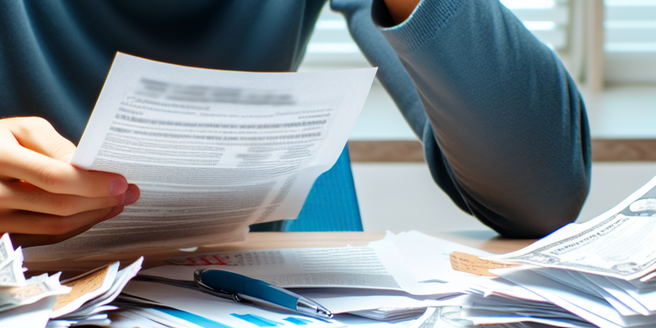
Understanding Your Debt: Where to Start
Recognizing the full extent of your debt is the first, crucial step towards settling it. This involves examining all of your bills, outstanding loans, credit card statements, and other obligations, considering not only major debts but also smaller amounts. Understanding and factoring in your total debt into your repayment strategy is essential.
Investigating how much you owe is half the battle, the second part is comprehending the complexities of it which includes confirming and understanding the interest rates linked with each obligation. Interest rates greatly affect your payment plan as each debt might have different rates, impacting the speed at which you can pay them off. Hence, including these rates in your budgeting and planning is crucial.
By integrating these steps into your debt management, you’ll get a comprehensive view of the situation, enabling you to create a practical strategy taking into account potential impact of interest rates on your overall payment plan. This method can make your journey towards becoming debt-free smoother and more structured, thereby precisely addressing every debt you owe, mitigating the risk of miscalculations or errors and progress towards debt repayment with more precision and efficacy.
Breaking Down Your Debt: How Much Can You Afford
Determining the amount you can allocate monthly towards your debt is critical and requires a careful examination of your financial health. It begins with a detailed review of your income from various sources like salaries, dividends, interests, and other inflows. A crucial part of this evaluation is understanding your expenses which range from fixed necessities, discretionary spending, to emergencies.
Take time to outline your expenditures which exist in two categories; fixed and variable costs. Fixed costs include set expenses like rent/mortgage, utilities, and subscriptions, while variable costs include expenses that can fluctuate such as groceries, entertainment, and personal care.
Being realistic about your lifestyle is necessary in this evaluation; prioritizing debt payoff while catering to daily living expenses. This not only refers to basic necessities like food, housing, transportation, and healthcare, but also enjoyable and recreational items like a coffee treat, Netflix subscription, or gym membership.
Though the process is challenging, it’s essential in ascertaining the amount to dedicate to debt each month. Balancing the need to speed up debt payment and maintaining a fulfilling lifestyle is tough, but careful planning and realistic budgeting allows gradual financial freedom without sacrificing happiness and peace of mind.
Crafting a Realistic Debt Repayment Plan: Tips and Tactics
Managing financial liabilities involves formulating a repayment strategy once you have the clarity about the extent of your debts and your monthly affordability. It is paramount to know the exact debt figures and your financial capacity to plan a viable and practical action plan. High-interest debts should be your priority as they accrue more interest over time, which may be from credit card surcharges or high-interest lending firms. It’s prudent to settle these debts first because the longer they remain unpaid, the larger they grow, increasing the total debt.
Oddly enough, paying off your smallest debts first can be beneficial. Although it feels counterintuitive, this approach primarily impacts your mental state rather than the monetary advantage. Clearing small debts provides immediate victories and mild reprieves, offering a psychological uplift, a feeling of accomplishment, and the motivation to remain on your financial recovery path. Each eliminated small debt signifies tangible progress towards financial freedom and serves as a constant source of motivation. Overcoming debt requires a positive attitude and determination on top of being a financial task. This proactive debt management approach helps maintain your repayments on track by keeping you involved.
Staying Motivated: How to Keep Up With Your Debt Repayment Plan
Staying determined and focused on your debt repayment plan can be challenging, but it is a crucial part of achieving financial freedom. Keep yourself motivated by recognizing and celebrating every stride you make, regardless of its magnitude, as these small victories create a positive reinforcement loop of motivation. Remember, debt reduction is a long-term effort, not a swift sprint, so patience is vital. If you stumble, don’t be disheartened – it is merely a part of the journey.
Don’t let obstacles dissuade you; carry on with your plan. Regularly reflecting on your plan, modifying it if necessary to align with shifts in your financial situation or objectives, is tremendously beneficial on your path towards a debt-free life. Adaptability is key for a smoother journey towards financial independence.
Reflecting on Your Journey: Acknowledging Progress and Adjusting Your Plan
Taking the time to pause and reflect upon your progress helps with motivation, bringing you closer to your objectives. Each achievement, even if minor, is worth celebrating as it signifies your determination and can motivate you further. Cherishing success in small tasks provides the reassurance needed to aim for even bigger goals.
Regular reassessment and scrutiny of your comprehensive plan is also crucial. Depending on your changing financial circumstances, the initial plan may need readjusting, so being flexible and willing to change methods when needed is key. The journey to achieving your goals can be unpredictable but staying open to new strategies and ideas is beneficial.
Maintaining a positive mentality is a powerful tool to navigate through any arising challenges. This optimistic attitude enables you to overcome any obstacles. Stay persistent, flexible, and positively committed to your pursuit. Reflect, analyze, and adjust as necessary to keep on track toward accomplishing your goals.
